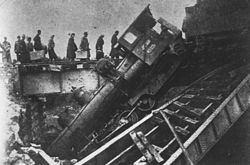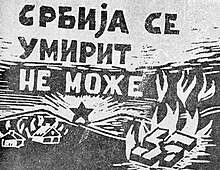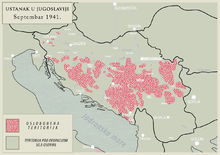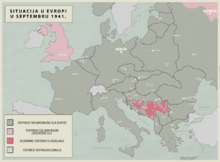
Back الانتفاضة في صربيا (1941) Arabic Soulèvement de la Serbie en 1941 French Revolta Sérvia de 1941 Portuguese Ustanak u Srbiji 1941. Serbo-Croatian Устанак у Србији 1941. Serbian
This article has multiple issues. Please help improve it or discuss these issues on the talk page. (Learn how and when to remove these messages)
|
| Uprising in Serbia | ||||||||
|---|---|---|---|---|---|---|---|---|
| Part of World War II in Yugoslavia | ||||||||
 Destroyed German train in Serbia, 1941 | ||||||||
| ||||||||
| Belligerents | ||||||||
|
|
|
| ||||||
| Commanders and leaders | ||||||||
|
|
|
| ||||||
| Casualties and losses | ||||||||
| 4,000 Chetniks & Partisans[3] |
200 killed 400 wounded[4] | |||||||
| 35,000 rebels and civilians massacred in reprisals[5] | ||||||||



The Uprising in Serbia was initiated in July 1941 by the Communist Party of Yugoslavia against the German occupation forces and their Serbian quisling auxiliaries in the Territory of the Military Commander in Serbia. At first the Yugoslav Partisans mounted diversions and sabotage and attacked representatives of Milan Aćimović's quisling administration. In late August some Chetniks joined the uprising and liberated Loznica. The uprising soon reached mass proportions. Partisans and Chetniks captured towns that weak German garrisons had abandoned. The armed uprising soon engulfed great parts of the occupied territory. The largest liberated territory in occupied Europe was created by the Partisans in western Serbia, and was known as the Republic of Užice. Rebels shared power on the liberated territory; the center of the Partisan liberated territory was in Užice, and Chetniks had their headquarters in Ravna Gora.
As the uprising progressed, the ideological rift between the two factions became more and more obvious. On one side the Chetnik detachments considered themselves loyal to the royal government-in-exile and fought for the restoration of pre-war order. On the other side, Partisans favored the introduction of socialism and the post-war reorganization of Yugoslavia on a federal basis. The Chetnik leader Dragoljub Mihailović abandoned the uprising in late October and entered into negotiations with the quisling government and the Germans in order to destroy the rival Partisans.
The Germans soon gathered a large force and quelled the uprising using mass terror, but the remaining Partisan forces crossed into Bosnia, where they formed the 1st Proletarian Brigade. After the collapse of the uprising, the Territory of the Military Commander was largely pacified until the return of the Partisans and the Belgrade Offensive in the second half of 1944. Meanwhile, the Chetniks became even more reluctant to fight against the Germans, and engaged in anti-Partisan operations and open collaboration. Nevertheless, Mihailovic was able to establish himself as the sole legitimate representative of the Yugoslav government-in-exile, and ordered that all resistance forces should fight under his command.
- ^ Božović, Branislav; Vavić, Milorad (1991). Surova vremena na Kosovu i Metohiji: kvislinzi i kolaboracija u drugom svetskom ratu. Institut za savremenu istoriju. p. 441. ISBN 9788674030400.
Октобар, новембар и почетак децембра 1941. године, протекли су у међусобним борбама четника са шиптарским и муслиманским формацијама.
- ^ Gledović, Bogdan (1975). Istorijski zapisi. Istorijski institut SR Crne Gore c. p. 47.
- ^ Nikolić, Kosta; Stambolija, Nebojša. "Royalist Resistance Movement in Yugoslavia" (PDF). Istorija 20 veka. 2/2018. Institut za savremenu istoriju: 16. Retrieved 26 May 2020.
By the end of December 1941 around 4,000 insurgents had been killed in fighting and 35,000 hostages had lost their lives
- ^ Nikolić, Kosta; Stambolija, Nebojša. "Royalist Resistance Movement in Yugoslavia" (PDF). Istorija 20 veka. 2/2018. Institut za savremenu istoriju: 16. Retrieved 26 May 2020.
The Uprising in Serbia during the summer and autumn of 1941 did not inflict serious losses to the German army (approximately 200 German soldiers were killed and 400 were wounded). German documents show the brutality with which the Wehrmacht handled the Serbian rebellion.
- ^ Nikolić, Kosta. Mit o partizanskom jugoslovenstvu. Beograd: Zavod za udžbenike, 2015, page:337, "Само у периоду од 1. септембра до 20. децембра 1941. године убијено је најмање 35.000 људи (устаници погинули у борбама и цивили стрељани у одмаздама)."